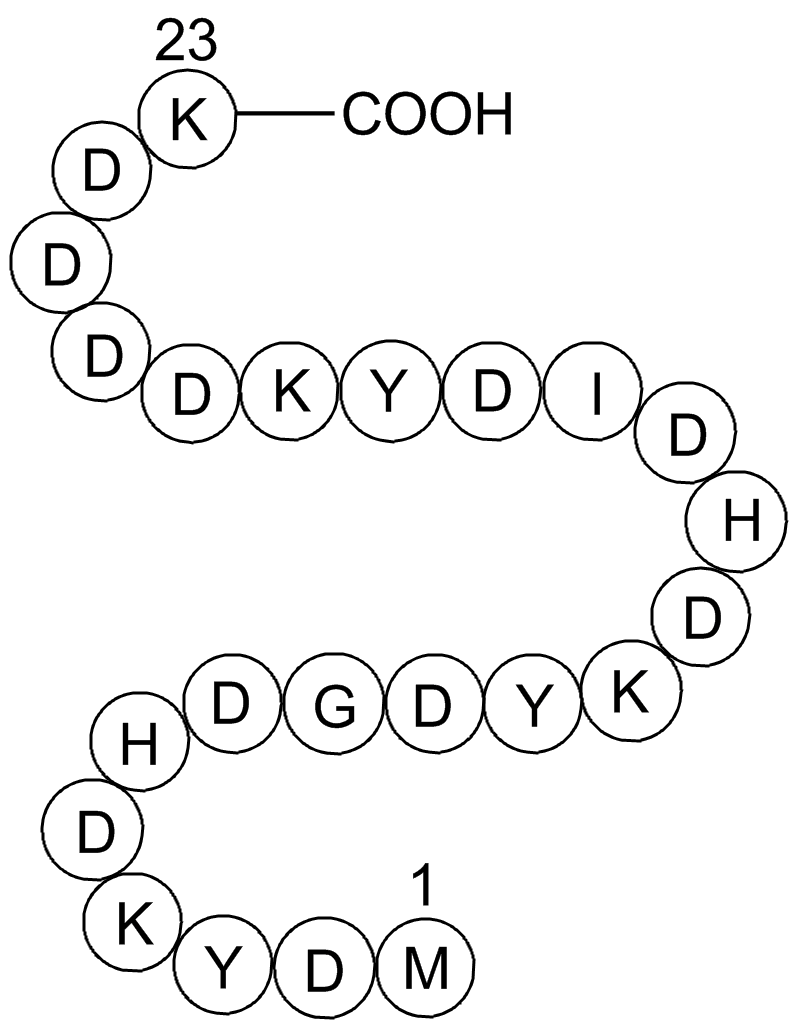3X FLAG Peptide
|
| Catalog No.GP10149 |
3X FLAG Peptide is a synthetic polypeptide containing three repeated DYKXXD amino acid sequences, often used to competitively bind Anti-Flag antibodies.
Products are for research use only. Not for human use. We do not sell to patients.

Cas No.: 402750-12-3
Sample solution is provided at 25 µL, 10mM.
- EMBO Rep (2023): e56834.PMID:37306046
- Mol Cell 82.19 (2022): 3553-3565.PMID:36070766
- NPJ Precis Oncol 7.1 (2023): 33.PMID:36966223
- Nucleic Acids Res 50.14 (2022): 8008-8022.PMID:35801922
- Drug Metab Dispos 51.10 (2023): 1342-1349.
- Gene Dev (2024).PMID:38503515
- Mol Cell (2024).PMID:38925115
- Nat Commun 15.1 (2024):5789.PMID:38987539
3X FLAG Peptide is a synthetic polypeptide containing three repeated DYKXXD amino acid sequences, often used to competitively bind Anti-Flag antibodies.3X Flag Peptide is mainly used for protein identification and purification, such as elution of Flag fusion expression proteins bound to Anti-Flag antibodies during immunoprecipitation[1-5].
References:
[1]. Hopp, T., Prickett, K., et al. A Short Polypeptide Marker Sequence Useful for Recombinant Protein Identification and Purification. Nat Biotechnol 6, 1204-1210 (1988). https://doi.org/10.1038/nbt1088-1204
[2]. Einhauer A, Jungbauer A. Affinity of the monoclonal antibody M1 directed against the FLAG peptide. J Chromatogr A. 2001 Jun 29;921(1):25-30. doi: 10.1016/s0021-9673(01)00831-7. PMID: 11461009.
[3].Gao XK, Rao XS, et al. Phase separation of insulin receptor substrate 1 drives the formation of insulin/IGF-1 signalosomes. Cell Discov. 2022 Jun 28;8(1):60. doi: 10.1038/s41421-022-00426-x. PMID: 35764611; PMCID: PMC9240053.
[4].Gao J, Huang G, et al.PROTEIN S-ACYL TRANSFERASE 13/16 modulate disease resistance by S-acylation of the nucleotide binding, leucine-rich repeat protein R5L1 in Arabidopsis. J Integr Plant Biol. 2022 Sep;64(9):1789-1802. doi: 10.1111/jipb.13324. Epub 2022 Jul 28. PMID: 35778928.
[5]. Lian H, Jiang K, et al.The Salmonella effector protein SopD targets Rab8 to positively and negatively modulate the inflammatory response. Nat Microbiol. 2021 May;6(5):658-671. doi: 10.1038/s41564-021-00866-3. Epub 2021 Feb 18. PMID: 33603205; PMCID: PMC8085087.
Average Rating: 5 (Based on Reviews and 29 reference(s) in Google Scholar.)
GLPBIO products are for RESEARCH USE ONLY. Please make sure your review or question is research based.
Required fields are marked with *





